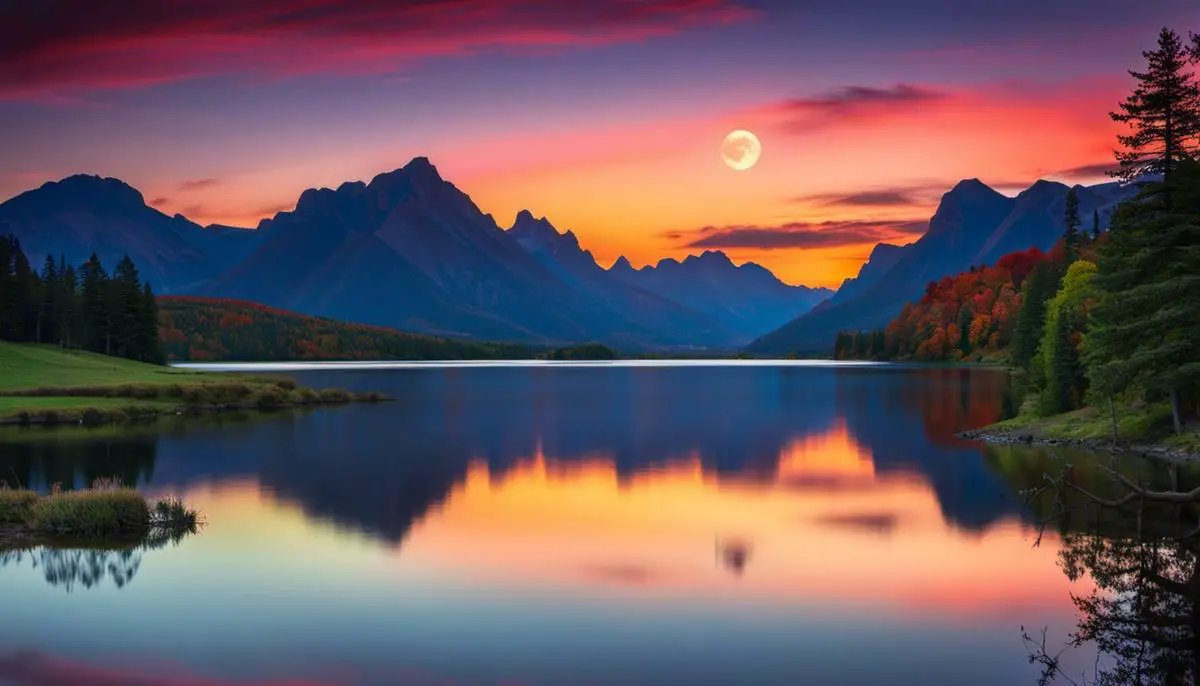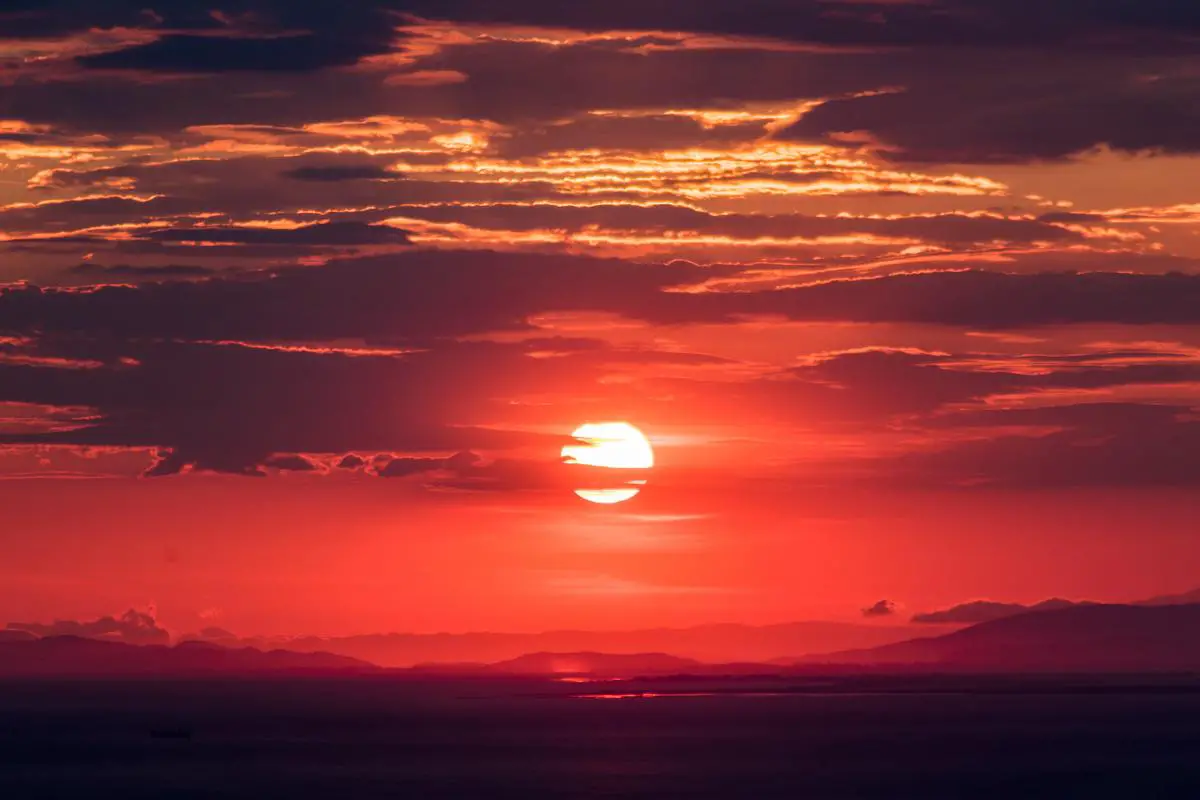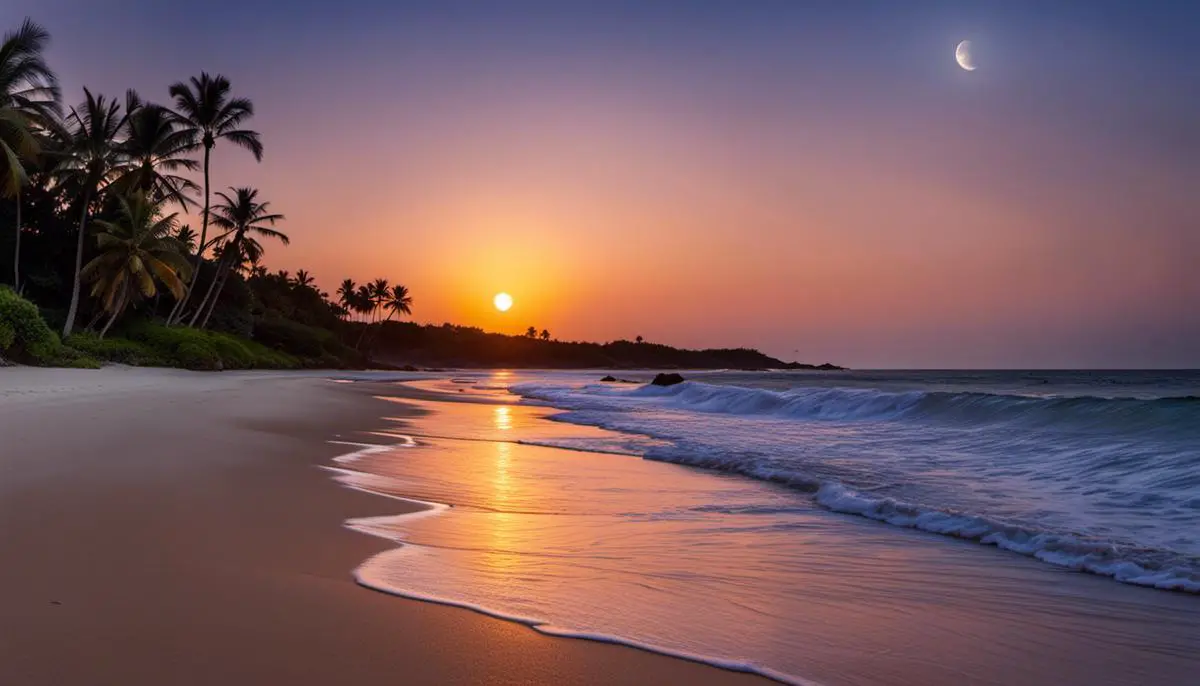The beauty and majesty of sun and moon sets have long fascinated mankind, with their vibrant hues painting the sky and creating silent yet captivating spectacles. As everyday phenomena, they hold significant values not only to the general public but also to photographers, astronomers, and nature enthusiasts. This discussion guides you through a journey of understanding these celestial phenomena, presenting breathtaking scenes from around the world, sharing photography tips to immortalize them, and unraveling the intriguing science behind their occurrence.
Understanding Sun and Moon Sets
Understanding Sun and Moon Sets: A Basic Explanation
Sunset and moonset describe the daily phenomena of the sun and moon disappearing below the horizon due to Earth’s rotation. This rotation causes the sun and the moon to appear to move across the sky from East to West, though it’s really the Earth that’s moving, not these celestial bodies. The times of the sun and moon set change throughout the year, depending on Earth’s tilt and its location in its orbit around the sun.
How Sunsets and Moonsets Occur
The sun sets each day in the West. Its setting marks the transition from day to night, with its final moment above the horizon commonly referred to as twilight. As for the moon, it doesn’t adhere to exactly the same daily schedule. Its orbit around Earth occurs about every 29.5 days, which means it rises and sets at different times throughout a lunar month. At times, this results in the moon being visible in the daytime or not at all during the night.
Differences between Sun and Moon Sets
Major differences between sunsets and moonsets include the predictable daily pattern of sunsets versus the monthly cycle of moonsets, and the visual effects each event offers. Sunsets often create a spectrum of warm colors stretching across the sky, while moonsets typically have a subtler, soft glow, sometimes accompanied by an apparent change in the moon’s size and color. This difference is due to the Earth’s atmosphere acting like a lens, which refracts or bends the path of light and changes how we perceive these celestial bodies.
Importance of Sun and Moon Sets
Sun and moon sets are integral to various human activities. For photographers, they offer spectacular opportunities for landscape and outdoor portraits. The striking colors and dramatic lighting during these times are distinctive, known as the ‘Golden Hour’ for sunsets and ‘Blue Hour’ for moonsets. Astronomers also value these celestial events as they can observe stars, planets, and celestial events that are not visible during the day or due to moonlight. Moreover, observing the sun and moon sets can help in predicting weather and navigating direction.
Fascination with Sun and Moon Sets
Nature enthusiasts and general observers find sun and moon sets to be a source of fascination. These are the moments when nature displays its most impressive palettes of color. They evoke feelings of calm and relaxation and provide a tangible reminder of the Earth’s movement in our solar system. From a philosophical perspective, they are often seen as symbols of the impermanent and cyclic nature of life.
Optimal Settings for Sun and Moon Sets
For the best view, clear skies without heavy cloud cover are optimal for observing sun and moon sets. However, a few scattered clouds can enhance the visual effect as they reflect the changing colors. High vantage points free from obstructions like buildings or trees also provide better views, and the proximity to reflective bodies of water can add another fascinating layer to the vista.
Understanding the varying nature of sun and moon sets can greatly enrich a multitude of experiences, whether they concern planning photography sessions, scheduling astronomical observations, or simply basking in the marvel of these celestial occurrences.

The Most Remarkable Sun and Moon Sets in the World
Santorini, Greece: Experience the Magnificent Sun and Moon Set in the Mediterranean
With its iconic white-plastered architecture and blue-domed churches, Santorini is lauded for offering mesmerizing sunsets and moon sets. The vibrant glow of both celestial bodies, framed by the majestic essence of the Aegean Sea, radiates their brilliance even more, producing a magic spectacle amplified by the island’s extraordinary geology. The dazzling transformation becomes especially prominent when the day’s pristine blue sky gradually gives way to the soft palette of gold, pink, and orange of the sunset.
Grand Canyon, Arizona: Spectacular sunsets beyond the ridges
The Grand Canyon in Arizona is a remarkable site for sun sets. The interaction between light and the canyon’s geology creates a dynamic display of colors and shadows. As the sun sets, the red and orange hues of the canyon deepen, enhancing the canyon’s grandeur. It’s equally exceptional for moon sets, as the moon’s glow luminescently reflects off the canyon’s rugged surfaces, creating an ethereal scene that complements the resounding silence of the desert night.
Mauna Kea, Hawaii: Uninterrupted views on a volcanic island
While it’s famous for its astronomical observatories, Hawaii’s Mauna Kea is also a brilliant location for viewing sun and moon sets. Due to its high altitude and minimal light pollution, you’ll witness the sun and moon’s celestial pathways in extraordinary detail. The sun set draped against the backdrop of the Pacific Ocean creates a dynamic spectacle of light unraveling across the infinite horizon. Meanwhile, moon sets at Mauna Kea offer a sense of solitude and tranquility, as the lunar silhouette immerges out of the dark Pacific night.
Uluru, Australia: Cultural significance in a dramatic sun set
Australia’s distinguished natural landmark, Uluru, offers a different sun set experience. As the sun lowers, the monolithic rock formation transitions through a palette of oranges, reds, and purples that highlight its intricate surface textures. This dramatic change in color wows spectators and adds a unique dimension to this natural phenomenon. For the local Anangu people, the changing colors of Uluru are of cultural significance, marking the transition from day to night. Moon sets here are subtly luminous, making the massive landmark gleam under the silver moonlight against the stark outback desert.
Manhattan, New York: Urban beauty in a concrete jungle
A stark contrast to the natural environments mentioned earlier, Manhattan, New York, provides an entirely different perspective for viewing sun and moon sets. Known as ‘Manhattanhenge,’ this biannual occurrence allows the setting sun to align perfectly with the city’s east-west street grid, creating a radiant spectacle that illuminates the city’s concrete canyon. The moon set, although not as famed, is nonetheless enchanting, casting a serene, silver glow over the city’s iconic skyline.
The Spectacle of Sun and Moon Sets
Across the globe, from the tranquil beaches of Greece to the panoramic canyons of Arizona, the magnificent sunsets and moon sets remain unparalleled in their beauty. No matter where you find yourself, be it Hawaii’s secluded peaks, Australia’s vast outback, or the vibrant streets of New York, each day ends with the captivating display of a sun and moon show. These natural performances, encompassing a breathtaking scope of colors and shapes, are universally revered and viewed with wonder.

Capturing Sun and Moon Sets: Key Photography Tips
Mastering the Photography of Light and Angles
When it comes to photographing the sun and moon sets, understanding light and angles is the key. The ‘Golden Hours’ – the first hour after sunrise and the last hour before sunset – are often the most promising times to capture spectacular images of the sun. With regards to the moon, pay attention to phenomena like the ‘moon illusion,’ which makes the moon appear larger when near the horizon. In both instances, the soft, warm illumination creates an unparalleled opportunity to capture remarkable shots of these natural spectacles.
Exploring Camera Settings
Camera settings play a vital role in capturing a beautiful sun or moon set. Here are a few recommended settings for this specific kind of photography. First, select a small aperture (like f/16) to get a sharp and vibrant image; this will help in bringing more depth and clarity. Photographing the moon specifically might necessitate a faster shutter speed to capture all the details. Experimentation is key in this aspect until the appropriate setting is found.
Using the Right Lens
For sunrise and sunset photography, a wide-angle lens is often best. It allows you to capture the vast expanse of the sky and landscape. On the other hand, telephoto lenses are better for moon photography because they allow you to capture the moon in detail and make it appear larger relative to other elements in the frame.
Planning the Composition
Consider unique and creative ways to incorporate natural and manmade elements into your frame. Including trees, mountains, or even buildings can add an interesting dimension to your photos and prevent them from looking too barren. Planning your composition in advance will help to create a balanced and eye-catching image.
Correct Metering and Exposure
Correct metering and exposure are essential tricks to capture sun and moon sets effectively. Using the camera’s spot metering feature will allow you to expose for the sun or moon correctly, avoiding a washed-out or overly dark image. Keep in mind that you might have to slightly underexpose the image for better colors and details.
Post-Processing
Post-processing is often the final step for any sun and moon set photography. Techniques such as enhancing the colors, sharpening the image, or cropping can greatly improve the final outcome. Consider using software like Adobe Lightroom or Photoshop. But remember, the goal is to enhance and not to overly modify the original image.
Getting into the craft of capturing stunning sun and moon sets isn’t something you pick up overnight. Instead, it’s an art that requires consistent practice, patience, and a solid understanding of various core elements such as lighting, angles, setting, and composition. With time, these elements can be effectively structured to enhance the aesthetic quality of your photography.

Photo by jeisblack on Unsplash
Scientific Explanations Behind Sun and Moon Sets
Decoding the Mysteries of Sun and Moon Sets
Being able to take fantastic sun and moon set photographs calls for an understanding of some basics of Earth’s rotation. Our planet rotates on an invisible axis that stretches from the North Pole to the South Pole, resulting in the cycle of day and night. As Earth spins, we perceive the sun making a journey across the sky, appearing to rise in the east and set in the west.
The moon follows a similar trajectory, appearing to rise and set with much the same pattern. One distinction, however, is the variability in the moon’s set and rise times. Unlike the sun’s relatively predictable schedule, the moon’s times change every day due to its elliptical orbit around the Earth.
How Atmospheric Conditions Factor In
Atmospheric conditions play a crucial role in determining the quality of a sunset or moonset. When the sun or moon is low on the horizon, the light that reaches us has to pass through more of Earth’s atmosphere compared to when these celestial bodies are directly overhead. The Earth’s atmosphere scatters short-wavelength light, such as blue and green light, to a far greater degree than longer-wavelength light, such as red and yellow.
In simple terms, the scattering of short-wavelength light by the atmosphere changes the color of the sky. During sunset or moonset, when the sun or moon is low in the sky, the light has to pass through a greater amount of atmosphere and the shorter blue and green wavelengths are scattered out of our line of sight, leaving the longer wavelengths dominant. This results in the vibrant oranges, pinks, and reds typically associated with sunsets and the occasionally deep oranges and reds of moonsets.
The Role of Earth’s Tilt & Rotation
The Earth’s tilt and rotation also impact the timing and appearance of sunsets and moonsets. The Earth’s axis is tilted at an angle of approximately 23.5 degrees relative to its orbit around the sun. Because of this tilt, the position of the sun and moon in the sky at any given time of day changes throughout the year.
During the summer months, when the tilt of the Earth’s axis is towards the sun, sunsets occur later in the day and the sun appears to move across the sky along a longer, higher arc. This results in a longer period of daylight. The opposite happens during the winter months, when the Earth’s axis is tilted away from the sun. Sunsets happen earlier, and the sun appears to move along a shorter, lower arc, resulting in a shorter period of daylight.
As for the moon, its orbit around the Earth is not perfectly aligned with the Earth’s orbit around the sun. This means that the moon can appear in various parts of the sky at different times of the year and can also influence the timing of moonsets.
Observing the Best Sun and Moon Sets
To witness the best sunsets and moonsets, understanding the factors highlighted above is key. The time of year and atmospheric conditions will either enhance or diminish the quality of these events. Locations with less atmospheric pollution and minimal obstructions to the horizon will offer the most picturesque views. Clear skies will provide the most striking sunsets, while partially clouded skies can enhance their depth and color. For moonsets, a clear sky with low atmospheric pollution is again ideal.
Lasty, remember to consider the phases of the moon. Full moonsets, in particular, are a beautiful and memorable sight. They occur just as the sun is rising, causing the sky to lighten and change colors while the full moon lowers and sets in the west.

Grasping the profound beauty and science of sun and moon sets leads to a newfound appreciation of these everyday natural phenomena. The exploration of their awe-inspiring displays around the world, the insights into capturing their essence through the lens, and the lucid explanation of their scientific principles, all contribute to enriching our perception. As we continue to marvel at these skyward spectacles, let’s also remember that they symbolize the ever-revolving cycle of life, reminding us of the constant ebb and flow in our own lives.
![]()
